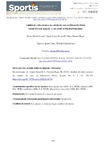Mostrar o rexistro simple do ítem
Análisis de redes sociales: un estudio de caso en Educación Física
| dc.contributor.author | Durán Lozano, Álvaro | |
| dc.contributor.author | López Secanell, Irene | |
| dc.contributor.author | Gimeno Raga, Marc | |
| dc.date.accessioned | 2022-03-21T18:43:19Z | |
| dc.date.available | 2022-03-21T18:43:19Z | |
| dc.date.issued | 2021-12-27 | |
| dc.identifier.citation | Durán-Lozano, A., López Secanell, I., & Gimeno Raga, M. (2021). Análisis de redes sociales: un estudio de caso en Educación Física: . Sportis. Scientific Journal of School Sport, Physical Education and Psychomotricity, 8(1), 136-151. https://doi.org/10.17979/sportis.2022.8.1.8714 | es_ES |
| dc.identifier.issn | 2386-8333 | |
| dc.identifier.uri | http://hdl.handle.net/2183/30089 | |
| dc.description.abstract | [Resumen] Este estudio analiza de forma gráfica las redes sociales en una clase de educación física de un centro público de secundaria de Valencia durante la pandemia del COVID-19, a partir de las conexiones que se producen entre los alumnos. El objetivo es comprobar el estado social del aula e identificar situaciones potencialmente problemáticas en el aula, a partir del análisis de dimensiones como la interacción agradable, el apoyo emocional, el apoyo social y el coestudio. Se utilizó una metodología cuantitativa mediante un cuestionario donde los estudiantes debían responder en función de su percepción del resto de compañeros a partir de varios ítems correspondientes a dimensiones sociológicas. Se realizó un análisis de redes sociales (SNA) y se extrajeron valores numéricos y gráficos que exponían la situación social del alumnado. Se hallaron problemas de integración, derivadas de las grandes diferencias de centralidad entre los alumnos más aislados y la media de la clase, así como una gran cantidad de conexiones en la dimensión “interacción agradable” y pocas conexiones en “apoyo emocional”. Se hallaron también diferencias sustanciales de liderazgo dependiendo de la dimensión de forma que los alumnos líderes en unos ámbitos, en otros no lo eran. Por último, se encontraron diferencias entre las conexiones cara a cara y digitales, siendo mayores estas últimas. Este estudio anima a los docentes de educación física a utilizar en SNA para conocer de forma objetiva la situación social de la clase, teniendo en cuenta el gran componente social que envuelve a una sesión de esta asignatura. | es_ES |
| dc.description.abstract | [Abstract] This study analyzes social networks in a physical education class in a public high school in Valencia during the COVID-19 pandemic. The main objective of this paper is to check the social status of the classroom and identify potentially problematic situations in the classroom, based on the analysis of dimensions such as pleasant interaction, emotional support, social support and co-study. To do this, a quantitative methodology was used through a questionnaire where students had to respond based on their perception of the rest of their classmates from various items corresponding to sociological dimensions. From this point, a social network analysis (SNA) was carried out and numerical and graphic values were extracted that exposed the social situation of the students. Integration problems were found, derived from the great differences in centrality between the most isolated students and the average of the class, as well as a large number of connections in the dimension “pleasant interaction”, and few connections in “emotional support”. Substantial leadership differences were also found depending on the dimension, so that the student leaders in some areas were not leaders in others. Finally, differences were found between face-to-face and digital connections, the latter being greater. This study encourages physical education teachers to use SNA to objectively know the social situation of the class, taking into account the great social component that surrounds a session of this subject. | es_ES |
| dc.language.iso | spa | es_ES |
| dc.publisher | Universidade da Coruña | es_ES |
| dc.relation.uri | https://doi.org/10.17979/sportis.2022.8.1.8714 | es_ES |
| dc.rights | Atribución-NoComercial-SinDerivadas 4.0 Internacional (CC BY-NC-ND 4.0) | es_ES |
| dc.rights.uri | https://creativecommons.org/licenses/by-nc-nd/4.0 | |
| dc.subject | Redes sociales | es_ES |
| dc.subject | Educación física | es_ES |
| dc.subject | Variables psicosociales | es_ES |
| dc.subject | Social networks | es_ES |
| dc.subject | Physical education | es_ES |
| dc.subject | Psychosocial variables | es_ES |
| dc.subject | COVID-19 | es_ES |
| dc.title | Análisis de redes sociales: un estudio de caso en Educación Física | es_ES |
| dc.title.alternative | Social Network Analysis: A Case Study in Physical Education | es_ES |
| dc.type | info:eu-repo/semantics/article | es_ES |
| dc.rights.access | info:eu-repo/semantics/openAccess | es_ES |
| dc.date.updated | 2022-03-21T18:26:23Z | |
| UDC.journalTitle | Sportis. Scientific Journal of School Sport, Physical Education and Psychomotricity | es_ES |
| UDC.volume | 8 | es_ES |
| UDC.issue | 1 | es_ES |
| UDC.startPage | 136 | es_ES |
| UDC.endPage | 151 | es_ES |
| dc.identifier.doi | 10.17979/sportis.2022.8.1.8714 |






